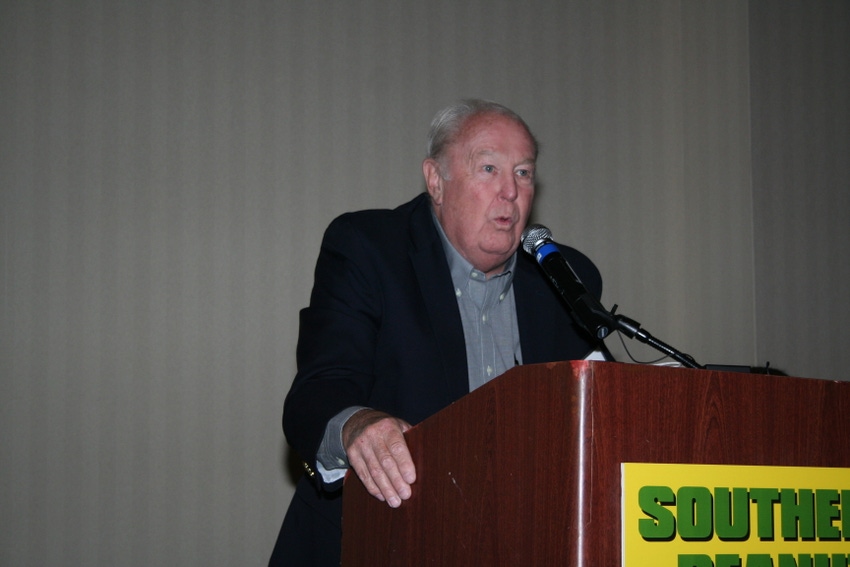July 19, 2013

Jack Chastain, a long-time peanut industry leader and recent inductee into the Peanut Hall of Fame, told growers and peanut industry leaders at last week’s Southern Peanut Growers Association meeting to embrace change or be willing to accept the dire consequences for not doing so.
Chastain is co-owner of Doster Warehouse in Rochelle, Ga. He has been in the peanut buying business since 1970, but has been a peanut farmer all his life.
“Back in the 1960s our growers were still growing some Spanish varieties and a number of runner type varieties, and then along came Florunner peanuts, and we thought we had it made,” Chastain said.
“Developing new peanut varieties didn’t stop, but many growers didn’t see the need for more varieties, because we had this new, highly productive Florunner,” he added.
“Back then, we didn’t see any need to plant more than 50-60 pounds of seed per acre. We thought more than that would crowd out each plant and most of the seed would rot in the ground.
“Fertilizer was standard, regardless of the ground on which a grower planted peanuts — 5-10-15 and 200 pounds per acre was plenty.
“I remember one year we had 6,000 acres of peanuts and cotton, and our total chemical bill was $25,000. Now, you can put much more than that on your pickup truck. Of course we were using DDT —and most of us survived it — and various dusts for insect control.
“We thought we had it made, and we did, if our goal was to grow a maximum of 2,000 pounds of peanuts per acre,” he said.
“Most peanut growers in Georgia at that time thought irrigation was too costly and too hard to deal with, and they were right, too. Moving aluminum drip irrigation lines is something I’ll never forget doing and something I hope no one ever has to do again, Chastain said.
Irrigation changed thinking
“Center pivot irrigation changed our thinking, and now underground, drip systems are improving efficiency, cost and labor. Last year, we grew the best peanut crop of my career using underground drip irrigation,” he said.
Perhaps the biggest change in peanut production has been in peanut harvest technology. The improvement in peanut harvesting equipment and techniques has made dramatic changes on peanut growers, buyers and end users.
“Back in the 1960s, peanut harvest might have run from August to November, but in most years, the vast majority of our peanuts were harvested by September, because that’s when our part-time labor, mostly college students, went back to school.
“I remember one year we actually harvested some Spanish peanuts in July. Now, some growers are still planting peanuts in July.
“All these changes in harvesting peanuts shortened the harvest season from 12 weeks to about six weeks now. Putting so many peanuts into the system changed things dramatically for shellers, blanchers, and on down the production line,” Chastain said.
“Up until 1977, the peanut program was status quo. After that there was still some quota, but the two price system put an end to buying and selling peanuts the way it had been done for decades.
“Everyone in the peanut business, from growers to shellers, had to change to survive. Since that time changes have come fast, and those who could adapt quickly enough survived and those who couldn’t change didn’t make it,” the peanut buyer said.
“We used to ship peanuts in one size — 125 pound boxes. Now, we ship in every imaginable size, up to containers that go directly to a port of shipment overseas,” he added.
Perhaps his greatest lesson in change in the peanut business came as a result of the 1980 drought, which produced a high percentage of Seg III peanuts. “At that time, we knew how to clean up Seg III peanuts, but it was illegal to do so. We actually were forced by U.S. laws in place at the time to import peanuts, a high majority of which were Seg III peanuts, and clean them up for sale to end users — that was legal,” Chastain said.
“Ten years later we had another drought and another poor quality crop of peanuts. This time around we could clean up the domestic crop and sell to end users.
“That put a high value on political changes that have subsequently saved the peanut industry in years like 2010, when we had a record high percentage of Seg III peanuts,” Chastain said.
More from Southeast Farm Press
Irrigation scheduling tools seen as a key to conserving water in southwest Georgia
Sunbelt Expo Field Day spotlights latest research, products
Kudzu bugs rapidly becoming challenge in Virginia soybeans
Some Alabama crops in make-or-break situation
About the Author(s)
You May Also Like






